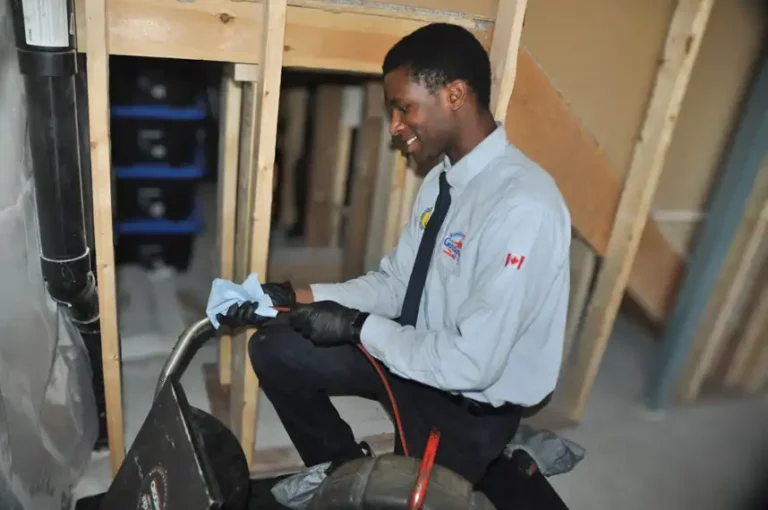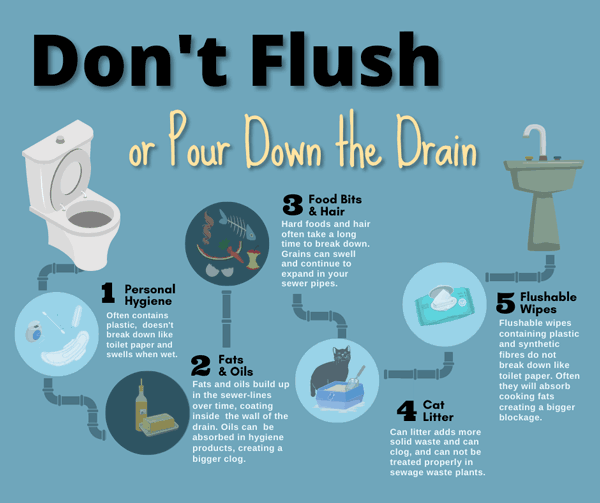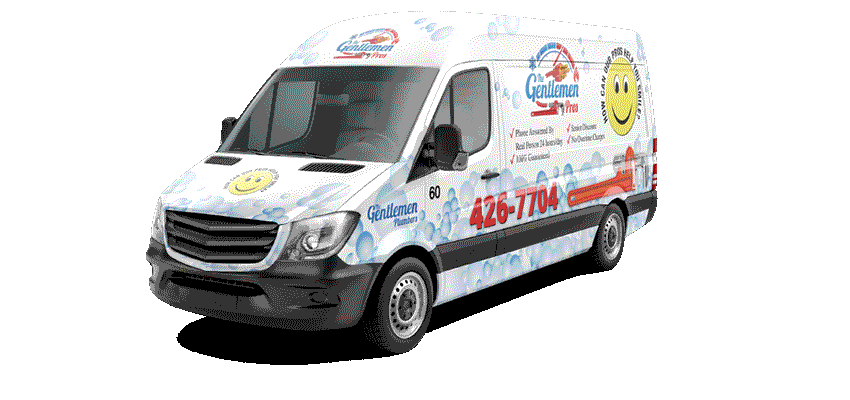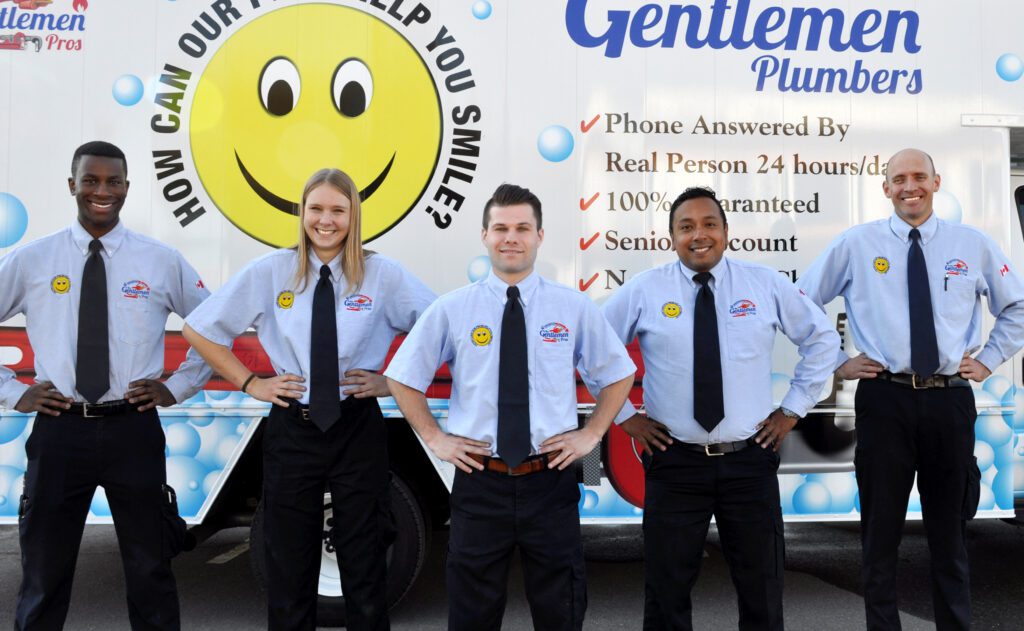We're In Your Neighborhood!

Same Day Service
Since 1992
Call The Gentleman Pros Now!
(403) 239-1943
We're In Your Neighborhood!


Same Day Service
Since 1992
Call The Gentleman Pros Now!
(403) 239-1943

We Have Investigated Thousands Of Sewer Backups And We Want To Share Everything We Know About Why Backups Happen. Our Ultimate Goal Is That You Never Have Another Sewer Backup Again!
“Dan was absolutely terrific. He was early and managed to solve our problem quickly and efficiently. His demeanour late on a Friday afternoon after a hectic day was outstanding and a pleasure to work with. Response time on an emergency service was impressive. Gentlemen Pros have provided us with key plumbing service for a very long time and I can’t imagine using someone else. Well done and thanks.” David D

This is a deep dive into the main causes of sewer backups.
So let’s dive right in!

Tampons can lead to sewer line clogs that are expensive to repair. Tampons Don’t Break Down When They Are Wet. (Toilet Paper For Example Is Designed To Break Down When Wet.) Instead, Tampons Swell And Expand. If An Existing Clog Or Obstruction Is In Your Sewer Line, Flushing Tampons Will Make It Worse! Final Words On Tampon Flushing — We Know It’s Convenient — But Don’t Do It!
No, they are not! (Put this on your social media, tell everyone you know!!) Flushable Wipes Are Designed To Have More Strength Than Toilet Paper And Usually Contain Plastic. They Are Extremely Destructive, Especially As They Absorb Grease And Hold Their Form. They Become A Ticking Time Bomb As They Create Clogs And Cause Problems In Your Sewer Pipes. So-Called “Flushable” Wipes Have Been The Rising Cause Of Blocked Municipal Sewer Systems In The Last Decade.
Oil and grease are major clog contributors. It’s Tempting To Pour Liquid Grease And Oil Down The Drain. (They Are So Deceiving In A Liquid State!) Out Of Sight, Out Of Mind And We Often Forget That Oil And Grease Harden As They Cool, Coating The Pipes And Creating Blockages. Oils And Fats Are Especially Problematic When They Are Absorbed By Personal Hygiene Products Like “Flushable Wipes” And Create Fatbergs.
Yes, that is really a thing! Read on. The Best Way To Dispose Of Bacon Grease, Animal Fat, Or Vegetable Fat Cooling To A Solid-State At Room Temperature, And Then Wipe The Grease Into The Garbage Or Compost. A Fatberg Is Pretty Much Exactly What It Sounds Like, A Compound Of The Words “Fat” And “Iceberg”.
A fatberg is a mass of congealed cooking grease and a combination of other non-biodegradable solids that gives the fat structure. “Flushable” Wipes, Cotton Swabs, Tampons, Pads, Condoms, Food Waste, Oil And Fat Collect In The Sewer Lines And Combine Together To Form Fatbergs, Causing Major Clogs In Sewer Lines — Yuck!
Fatbergs have been found in city sewer systems all over the world, including London, New York, Dever, Baltimore, Liverpool, and Melbourne. The Largest Fatberg Was Found In Liverpool, England, Weighing 440 Tons (400 Metric Tonnes) And Measuring 820 Feet (250 Meters) Long.
If you are visiting London, check out The Museum of London’s exhibit featuring two pieces of a fatbergs.
Should Food Waste Be Put Down The Drain?
Food waste can easily clog drains. (Composting is better for the ecosystem, too.) Often The Wrong Foods Are Put Down The Drain Or Garbage Disposal. Eventually, This Can Cause Or Contribute To Clogs And Backups. Sewer Clogs Don’t Form Overnight. (Usually!)
Do not put the following down the garbage disposal or drain:
You are probably thinking, my garbage disposal can cut through most of those. It Probably Can But Your Garbage Disposal Is Not What Is In Question. It’s The Fact That Even After Your Garbage Disposal Has Done Its Job, The Resulting Bits Of Food Can Still Cause A Clog In Your Sewer Pipes.
The following section will explain in further detail how and why food bits and other waste can get stuck in pipes.
To conclude, words to live by…
Trust us! Use the 3 P’s — paper (as in toilet paper), pee, and Poop — as a guide of what and what not to flush.!
Damaged or aged pipes can slow down or stop the flow of wastewater from your main sewer line to the municipal sewer lines.
We can’t say enough about the importance of a sewer line camera inspection! Buried sewer pipes could be silently wreaking havoc because of an unseen crack, faulty joint, pipe misalignment, collapse, or belly.
Here’s what that might look like in your sewer.
Cracks are common with older pipes. Cracks can leak wastewater and result in softening the supporting packed soil and gravel. If leaks due to cracks are unchecked in time they can loosen the packed gravel supporting the sewer pipe. Consequently, the sewer pipe can belly, or become misaligned.
(What are those? Read on — we’ll get to it.)
Cracks become more problematic when roots make their way through the cracks of the sewer line, consequently causing a sewer line backup.
A pipe belly is when there’s a “sag” in the pipeline.
Pipe bellies occur when the ground under the pipe can no longer support the pipe. This usually happens when the ground becomes soft due to water leaking from the pipe or when the ground was not compacted properly when the pipe was installed.
Pipe bellies catch water and waste because there isn’t enough slope in the pipe for the waste to continue traveling to the municipal sewer line.A blockage forms over time.
Sewer pipes tend to outlive the joints connecting them together. When joint seals wear down, water can leak out and in time can attract root growth or cause the sections of pipe to misalign. Consequently, old sewer joints can be the cause of major backups.
This brings us to our next sewer pipe issue.
Misaligned, or offset sewer pipes are when the joints don’t properly line up. Misaligned pipes can cause major plumbing backup and problems. Sewer pipe misalignment can be a result of the weakening of the compacted soil supporting the sewer line. When the compacted soil softens, the pressure from the top soil causes the pipe to misalign. Pipe leaks can cause the ground to soften and shift, and can even wash away the compacted ground supporting the sewer pipe.
Sewer pipe misalignment can also be the result of root invasions. When the pipe joints weaken, tree roots (thirsty for water and fertilizer) can enter through the joints and grow inside the pipe. As the roots get larger, they may push the pipes until they misalign.
A sewer pipe collapse typically results from aged pipes, tree root invasions, or misaligned pipes. A sewer pipe collapse is a disaster!! Not only will your sewer line backup, the cost to repair will be more expensive!
Get annual camera inspections of your main sewer line so you can identify a problem before it becomes a collapse!! Older pipes are more prone to collapse as the pipe material and joints wear out. This is especially true for non-plastic pipes.
So you might be asking yourself, what kind of pipes do I have and how old are they? Good questions! In this next section we will identify different types of sewer pipes, when they were most commonly used, and which types are problematic.
Knowing when your house was built will help determine the type and age of your sewer pipes. Each type of sewer pipe is prone to different types of issues including cracks, joint issues, pipe misalignment, pipe belly, or collapse.
Clay sewer pipes were used commonly from the early 1900s to the 1960s, and have a typical lifespan of 50 to 60 years. Clay was the material of choice because it does not rust. Unfortunately, clay sewer pipes have a tendency to crack and crumble. Their joints were often made from clay putty that breaks down over time.
The most common issues with clay pipes are:
Asbestos cement sewer pipes, also known as AC pipes or transite pipes were used most often between 1945 and 1970 in North America. They have about a 50-year life span. Asbestos?! Yes, asbestos was a common building product at that time.
Before your blood pressure continues to rise as you think of all the health hazards associated with asbestos, let me remind you of something. AC sewer pipes carry sewage water away from you, they do not bring drinking water to you.
So you can relax….sort of. AC pipes do wear out, and sometimes before their projected 50-year life span. They tend to crack, crumble, and leak.
No Corrode, Orangeburg, or “black pipe” has a history of collapsing and breaking down before their projected 50-year life span. The pipe often flattens at 30 years.
Described as a “coal tar impregnated toilet paper tube”, No Corrode pipe was commonly used across Canada and the United States after WWII until the 1970s. No-Corrode pipe or Orangeburg pipe (named after the manufacturer) was made from wood fibers and impregnated with coal tar.
This sewer pipe is a nightmare! Over time the pipe becomes “soggy”, causing the pipe to collapse. Because the pipe is made with organic compounds, wood fibre and tar, and is flowing with fertilizer (sewer water) it is a prime target for root invasions.
Cast iron sewer pipes were commonly used in the earliest plumbing systems in the 1900’s up until the 1970s. They fail when they rust or when the joint seals break.
Interior corrosion causes rough surfaces on the inside of the pipes that catch waste and debris forming buildups.. (This is another circumstance when flushing the wrong things can be especially harmful.) Cast iron pipes will all rust from the outside in when there is a high concentration of sodium in the soil.
Cast iron pipes were joined using the bell and spigot system, and over time the seals on the joints will deteriorate. When joint seals break sewer pipes leak and are susceptible to root intrusions, bellies, and misalignments.
The material of choice for residential sewer lines since the 1970s is plastic. Because they are made of plastic, PVC (Poly Vinyl Chloride) or ABS (Acrylonitrile-Butadiene-Styrene) pipes do not rot, rust, or corrode.
These pipes’ interiors are smooth, meaning food waste and debris can’t catch on them, limiting the chances a clog will form. PVC pipes are less likely to crack as the soil sets or moves and is slightly more flexible than ABS.
ABS pipes are stronger than PVC pipes and can withstand severely cold temperatures, making them ideal for cold long winters. Issues with PVC and ABS pipes are rare and they are less likely to fail compared to other pipes. They have a life expectancy of 100 years. Issues with PVC or ABS pipes are rare compared to older pipes.
Root intrusion in PVC (and ABS) pipes typically only occurs if the joints are not installed properly. To ensure the joints are installed correctly, make sure the pipes are thoroughly and properly cleaned before the glue is applied to the joint. A tree root can get through the tiniest crack in a joint, and this tiny hair sized root will eventually grow and become a big problem. This is why you want to make sure you have solid watertight joints.
Tree roots can also invade sewer systems through cracks, bellies, and misalignments. Tree roots are especially problematic in older pipes.
Keep reading to learn more about the problem of tree root invasions!
Can tree roots really cause that much damage to my sewer pipes and drains?
That’s a BIG Yes!!
Tree roots are the number one cause of main sewer line blockages and backups, especially in older homes. As sewer pipes age, joints typically lose their integrity before the pipes do. If sewer pipes break or wear out, even the smallest leak can encourage root growth in the pipe.
The main sewer pipe provides nutrient-rich wastewater and air, creating the ideal environment for root growth. Hair-like roots can grenter through small cracks and grow into bigger tree roots, eventually creating a blockage. As the roots grow, they form a root ball. The root ball acts as a net and catchest toilet paper, food waste, and other debris as wastewater moves the debris through the sewer pipe.
The combination of flushing the wrong things and a root invasion in your main sewer line can be obstructive. In time, as the roots grow in and around the pipe, the roots can cause further pipe damage, like a pipe misalignment.
Bottom line…
Get an annual camera inspection of your main sewer line!!!Signs of leaks, damage, root growth, and clogs are hard to detect ahead of time and a camera inspection will help you find them before they become a big problem..
If your sewer lines are buried only a few feet deep, look for soggy patches or extra green patches of grass in your yard. These patches could indicate a leak in your sewer pipe.



